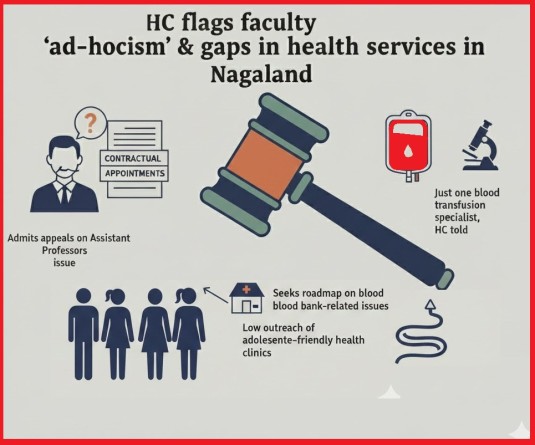
Six “slum” areas in capital
Al Ngullie
Dimapur | July 12
The much-hyped City Development Plan (CDP) for Kohima town, selected for one of the biggest development ventures in decades by the Central Government, may have some serious holes to patch up. The City Development Plan for Kohima town, which is a prerequisite for availing funds under the JNNURM scheme, for an amount of Rs. 1869 Crore, has already been dispatched to the Government of India in March, 2006.
Colossal as the funds are, the critical assessment of National Institute of Urban Affairs punched a number of holes in the CDP detail for Kohima. The report contained CDP appraisals and assessments of townships and cities in India selected for the mega-development project. A copy of the study obtained today, contained an assessment of Kohima’s CDP as well, among other cities of the country.
A good number of lacunas and inconsistencies were elaborated in the assessment report of New Delhi-based National Institute of Urban Affairs. One of these include questions on the claims in Kohima’s CDP that “65.1% of the BPL population” in the town, if there are no squatter areas, and they don’t live – interestingly – in “slums” either, then where.
The most damaging observation of the assessment was over the state government’s claimed capacity to finance even 10% of the funds under JNNURM. The Kohima CDP states “Nagaland state government finances are in a precarious position with rising fiscal and revenue deficits”. The state government could hardly generate 7 percent of revenue and the rest of the revenue is from central government transfers. In actual terms, an own revenue income is only Rs.170 crores against the central government transfers of Rs.2138 crores for the year 2005-2006.
The CDP further elaborated that “The ULBs in Nagaland depend a great deal on the state government to finance not only their capital expenditure but even their recurrent expenditure”. From this, the study said, it follows that the state government of Nagaland is highly dependent on Central government transfers and the ULBs in turn, on the state government. “Under the present circumstances, it is questionable as to how the state government to will be able to finance even 10 percent of funds under JNNURM,” the assessment said.
“Slums” in Kohima
A new and curious fact for the Naga citizen may be a claim in the Kohima CDP mentioned by the NIUA that “26% of the population of Kohima” live in “slums” while the BPL population “residing in slum areas” is “34.9%” of the total BPL population.
Similar interesting ‘facts’ – if not surprising and incongruous – are elaborate explanations understood to have been given by the Nagaland government about the existence of “slums” in the town itself. In fact, the National Institute of Urban Affairs’ assessment referred to six “slum” areas understood to have been designated so in the government’s CDP. The gauge and infrastructural dimensions by which the areas could be designated as “slums” was not elucidated. In many of the CDPs, the study said, the “drawbacks” were the visions and strategies to providing focus on Basic Services to the Urban Poor (or BSUP) with infrastructural build-up and maintenance in the “slum” areas.
In Kohima for instance, the report noted that only 34.9% of the Below Poverty Line (BPL) population lives in the “slums.” If “slum” areas are targeted only, 65.1% of the BPL population shall not be affected at all, the report rationalized.
“Details must be provided as to how the 65.1% of the BPL population, which does not live in the slums, live. As the CDP states, some high-income groups also stay in the slums while majority of the BPL population lives in areas that are not notified as slums. For the JNNURM to really serve the urban poor, this is essential,” the assessment said.
Again, the institute said Kohima’s CDP envisions a better “access to housing and basic infrastructure” for the urban poor. So far, the coverage of poverty alleviation plans since 1989 has been inadequate. According to the CDP, only 9% of the BPL population has been benefited from anti-poverty programmes, the study noted.
“However the basis for arriving at this figure is unclear. Building footpaths, public wells, sewerage drains, roadside drains, public toilets and roads shall do this. The total outlay for slum up-gradation is Rs.56.31 million. However according to the table on page 16-39, the investment needed is Rs.258.315 million. Thus this must be clarified,” the critical assessment said.


.jpg)



